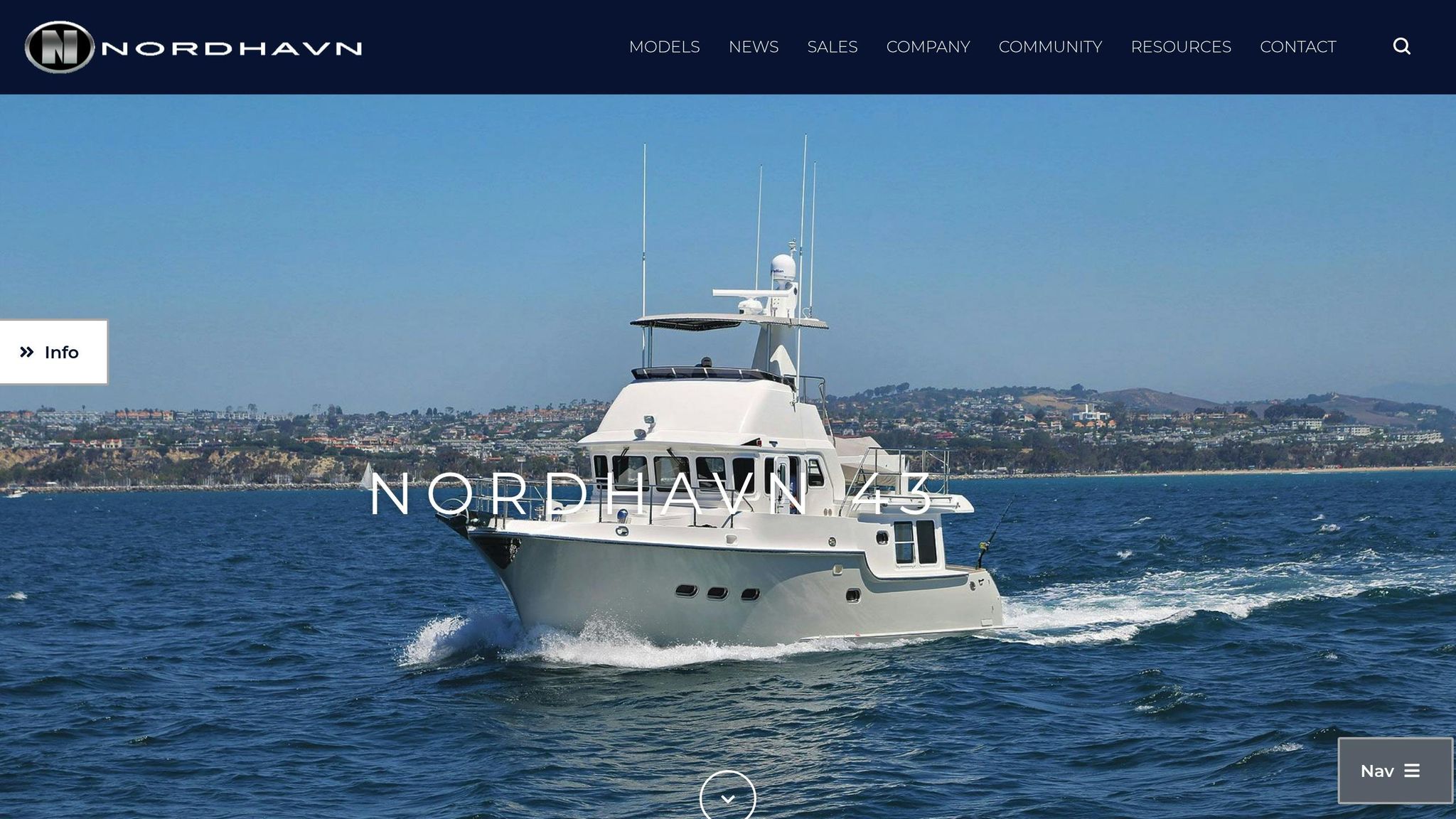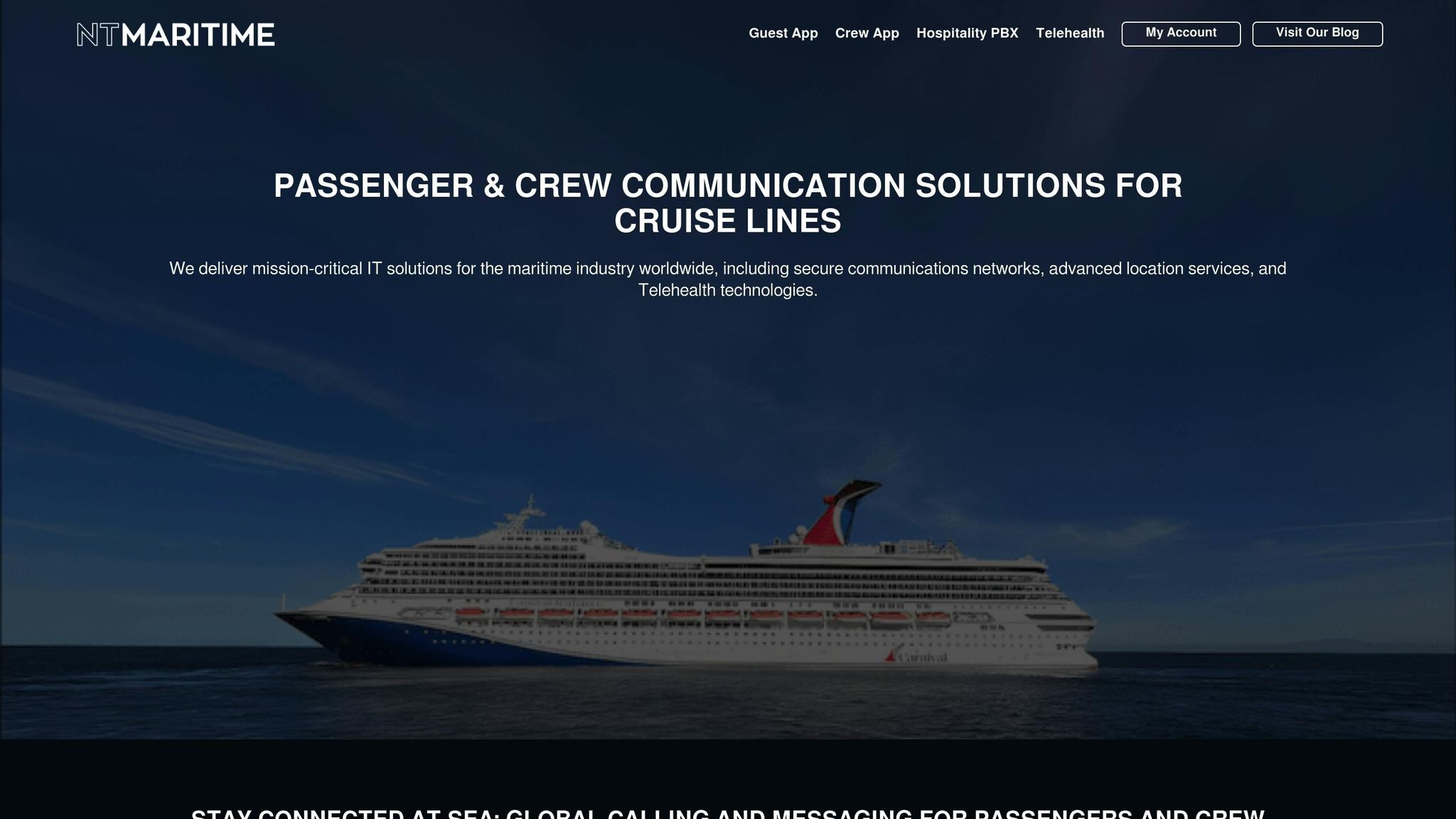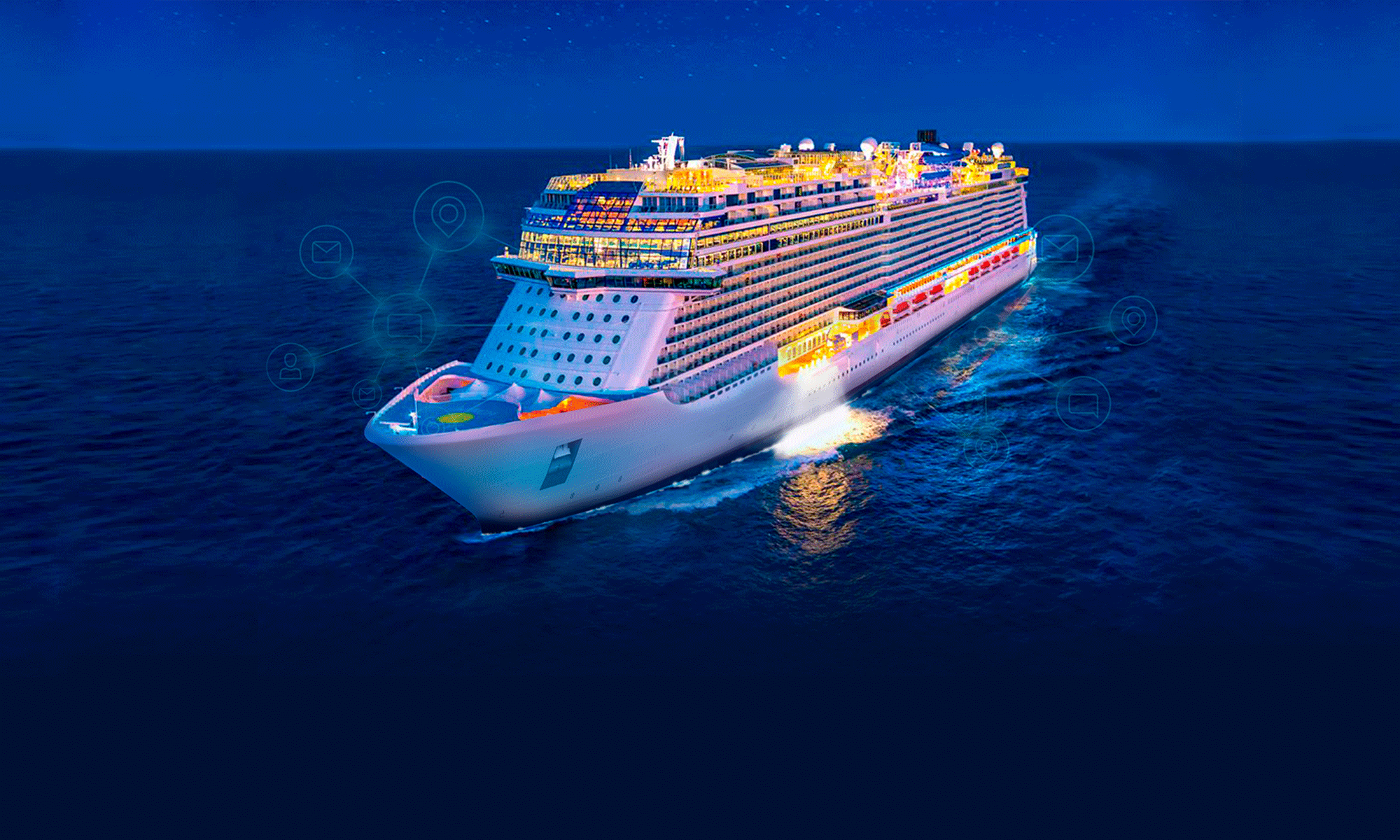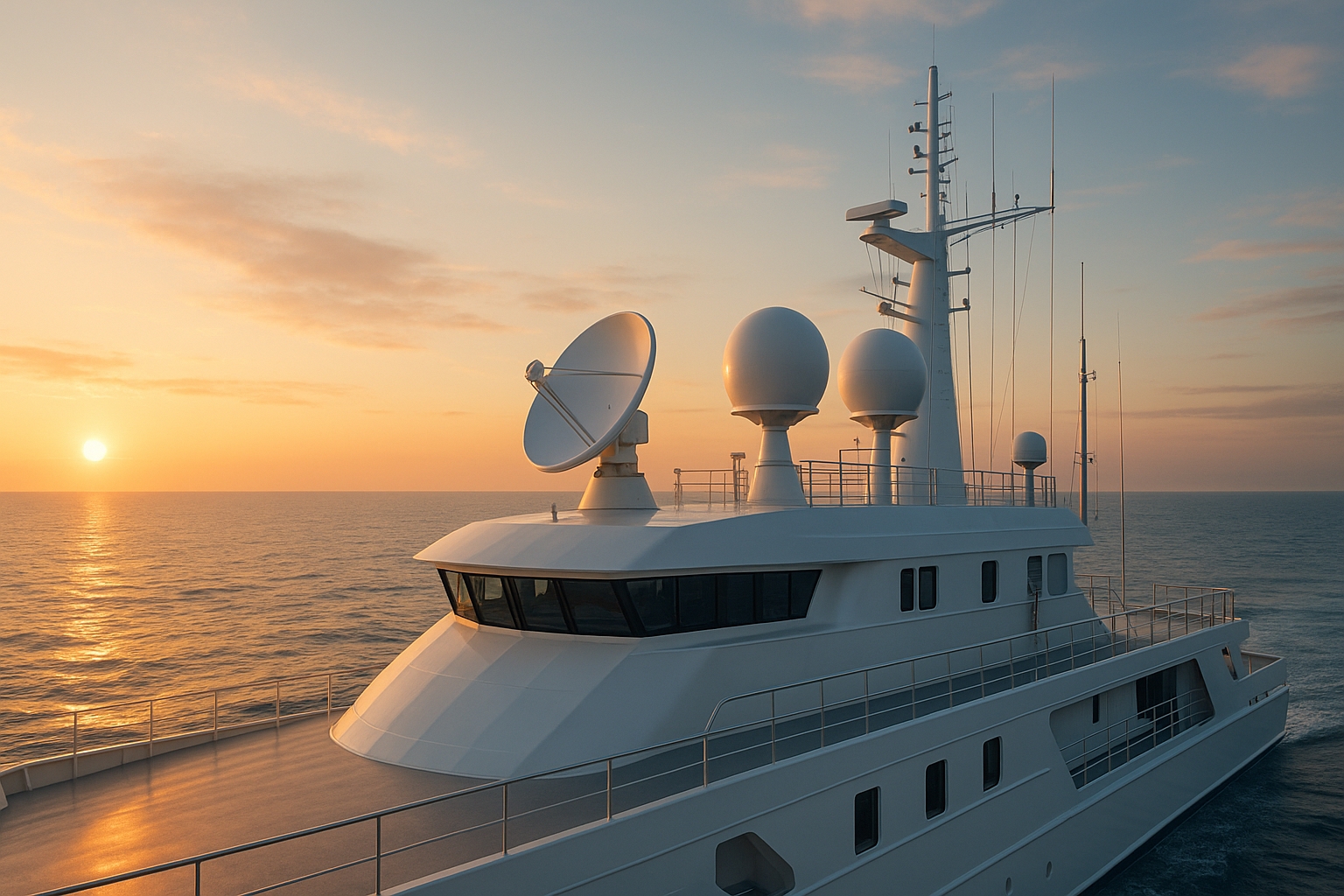Want faster internet on your ship? Here are five practical ways to boost connectivity for passengers, crew, and operations:
- Upgrade Satellite Connections: Use Low-Earth Orbit (LEO) satellites for lower latency and faster speeds. Keep equipment well-maintained and choose providers with reliable coverage and flexible plans.
- Implement Bandwidth Management: Prioritize critical tasks like navigation and safety, while managing personal use during off-peak hours. Use tools for real-time monitoring and traffic control.
- Upgrade IT Systems: Invest in marine-grade routers, switches, and Wi-Fi 6 technology. Regularly inspect cables, equipment, and network performance to avoid bottlenecks.
- Use Local Caching: Store frequently accessed content locally to reduce satellite reliance and improve loading times for users.
- Combine Internet Sources: Hybrid systems merge satellites, cellular networks, and other sources for uninterrupted service and better reliability.
Quick Comparison:
| Method | Cost | Effort | Speed Gains | Reliability | Maintenance |
|---|---|---|---|---|---|
| Satellite Optimization | Low-Medium | Quick | Moderate | High | Regular checks |
| Bandwidth Management | Low | Easy setup | Noticeable | Medium | Monitoring |
| IT System Upgrades | High | Long-term | Major | Very High | Routine checks |
| Local Caching | Medium | Moderate | Improved | Medium | Regular upkeep |
| Hybrid Connectivity | Very High | Complex | High | Exceptional | Coordinated |
These strategies ensure better connectivity, smoother operations, and happier users at sea.
How to get INTERNET on a boat + WeBoost cell booster performance review [NORDHAVN 43]

1. Improve Satellite Connections
Satellite technology plays a critical role in maritime internet, but not all systems deliver the same performance. Low-Earth orbit (LEO) satellites, positioned just 310 to 1,240 miles above Earth, offer a significant advantage over geostationary satellites, which orbit at around 22,370 miles. This shorter distance reduces signal travel time, cutting down latency and making real-time applications like video calls and navigation far more efficient.
"LEO satellites, positioned closer to Earth than traditional satellites, offer several advantages over their higher‐altitude counterparts. With increased data transfer speeds, LEO satellites provide a reliable and efficient solution for seamless communication." – Defence Digital
A real-world example of LEO technology’s potential came in December 2023, when the Royal Navy‘s HMS Protector used it to deliver Wi-Fi to 90 crew members. This allowed them to stay connected with their families during deployment. LEO networks achieve global coverage by operating through constellations of multiple satellites, ensuring connectivity even in remote maritime areas. However, maintaining these systems is crucial to fully benefit from their capabilities.
1.1 Keep Satellite Equipment Working Properly
To ensure fast and reliable internet, maintaining satellite equipment is non-negotiable. Preventive maintenance can help avoid issues like signal interruptions, system breakdowns, and declining performance. For example, regular visual inspections of antennas can catch problems such as physical damage, dirt, or corrosion – any of which can degrade signal quality. Proper alignment of antennas is equally important for stable connectivity.
Keeping firmware up to date is another essential step to maintain peak performance. Electrical systems also require attention; inspecting batteries, cables, and connections can help prevent power failures that disrupt communication. Additionally, training crew members in basic troubleshooting and proper equipment use can help tackle minor issues before they escalate into major problems.
1.2 Select the Right Satellite Provider
The choice of satellite provider directly affects internet quality. It’s essential to confirm that the provider covers all necessary maritime routes, including remote and polar regions. Look for comprehensive coverage paired with sufficient bandwidth and low latency to meet operational demands.
Flexibility is another key factor. Providers offering scalable options – such as 30-day rolling contracts or hybrid solutions combining cellular and satellite connectivity – allow you to adjust services as your needs change. Evaluate the quality of the equipment they provide, as modern, reliable terminals can reduce maintenance headaches.
Don’t overlook the pricing model. Make sure to account for all costs, including equipment, monthly fees, and data plans, to avoid surprises. Security is also critical, so prioritize providers that use strong encryption and comply with maritime regulations. A proven track record and strong reputation in the industry can give you added confidence in their reliability.
2. Use Bandwidth Management Tools
Efficient bandwidth management can make all the difference between seamless operations and a frustrated crew. On vessels where bandwidth is both limited and expensive, smart allocation ensures critical systems run smoothly, while personal use is reserved for off-peak times.
Modern bandwidth management tools provide precise control over how internet resources are distributed. These tools dynamically adjust traffic flow based on current needs, ensuring that essential systems like navigation and safety communications always have the bandwidth they require. They lay the groundwork for the more detailed controls and real-time adjustments discussed below.
2.1 Control Traffic Flow and Set Priorities
Traffic shaping technology allows you to establish rules that automatically prioritize different types of internet usage. For example, you can configure the system to give emergency communications and navigation the highest priority while deprioritizing non-essential traffic.
Quality of Service (QoS) rules help categorize network traffic into priority levels. Critical ship operations, such as GPS updates, weather data downloads, and safety communications, can be assigned the highest priority. Business-related applications, like cargo tracking and port communications, might take a middle tier, while personal use by the crew is given lower priority during peak operational times. However, during off-duty hours, the system can allocate more bandwidth for personal activities.
Deep Packet Inspection (DPI) takes traffic management a step further by analyzing the content of data packets. This granular insight allows for even more effective prioritization, ensuring essential communications remain uninterrupted while less critical traffic is managed accordingly.
2.2 Track Usage with Real-Time Data
Real-time monitoring tools provide complete visibility into bandwidth usage, tracking metrics like throughput, latency, and connection quality to optimize performance.
These advanced systems can detect unusual activity and analyze trends, helping you make informed decisions about bandwidth upgrades or policy changes. For instance, if a single device starts consuming an unusually high amount of bandwidth or if connection quality suddenly drops, the system can send immediate alerts to IT personnel.
Custom alerts can notify IT teams when bandwidth usage or latency crosses predefined thresholds, allowing for quick action to prevent minor issues from escalating.
The data gathered through real-time monitoring also plays a critical role in long-term planning. By studying usage patterns over time, you can identify trends that guide decisions on bandwidth upgrades, equipment replacements, or adjustments to usage policies. This historical data can be especially useful when planning connectivity solutions for specific routes.
Artificial Intelligence (AI) and machine learning are increasingly being integrated into these monitoring systems. These technologies can predict potential problems before they arise by learning regular usage patterns and automatically adjusting bandwidth allocation or sending alerts when something seems off.
3. Update Onboard IT Systems
Reliable onboard IT systems are key to preventing bottlenecks and ensuring smooth, high-speed internet for both operational needs and passenger use.
The maritime environment poses unique challenges for IT hardware. Salt-laden air, constant vibrations, temperature swings, and limited space can all take a toll on networking equipment. Devices designed for land-based use may falter or fail entirely in these harsh conditions, making it essential to invest in marine-grade components specifically built for life at sea. Here’s how upgrading critical networking systems can make a difference.
3.1 Install Better Networking Equipment
For fast and reliable onboard internet, modern routers, switches, and Wi-Fi access points are non-negotiable. Marine-grade equipment is designed to withstand corrosion and shocks while supporting advanced technologies like Wi-Fi 6, which performs up to four times better in crowded networks compared to older standards.
Mesh networks are a game-changer for ships. By using multiple access points that work together, they eliminate dead zones and ensure consistent speeds across the vessel. These systems automatically direct traffic through the strongest connection, keeping everyone connected no matter where they are on board.
PoE+ switches are another smart addition, combining power and data delivery into a single cable. With up to 30 watts per port, they can support high-performance access points without requiring separate power sources.
To further optimize performance, network switches with hardware-level QoS (Quality of Service) prioritize essential traffic, ensuring that critical communications remain uninterrupted even during periods of heavy usage.
These upgrades create the backbone for high-speed services, such as NT Maritime’s impressive 220 Mbps download speeds with latency under 99ms.
3.2 Check Infrastructure Regularly
Upgrading hardware is only part of the equation – routine maintenance is just as important to keep networks running smoothly. Regular inspections of cables, connection speeds, and equipment temperatures can help catch potential problems early.
In marine settings, cable integrity is especially critical. Ethernet cables exposed to salt air can corrode at connection points, leading to frustrating intermittent issues. Using marine-grade cables with proper shielding and corrosion-resistant connectors can help avoid these headaches.
Periodic network performance testing from various points on the ship is also essential. This helps identify weak spots where signal strength drops or speeds lag. If interference is detected, it might be necessary to relocate access points or add shielding to improve coverage.
Temperature control in equipment rooms is another key factor. Keeping the temperature between 50°F and 85°F (10°C to 29°C) ensures optimal performance. Installing temperature sensors with automatic alerts can help crew members address cooling problems before they lead to equipment failure.
Keeping detailed documentation of the network infrastructure – such as cable layouts, equipment locations, and configuration settings – is invaluable for troubleshooting. This information should be updated whenever changes are made and stored both digitally and in hard copy for easy access during emergencies.
Finally, having backup equipment on hand is a smart precaution. Spare routers, switches, and access points can be quickly swapped in if primary components fail, minimizing downtime and keeping essential operations online.
sbb-itb-bda822c
4. Set Up Local Caching and Content Storage
In the demanding maritime environment, local caching plays a key role in reducing delays and overcoming the challenges of satellite-based connectivity. By storing popular content locally, caching servers help ships deliver faster access to passengers and crew while cutting down on the reliance – and expense – of satellite connections.
4.1 How Caching Servers Work
Caching servers act as a local storage hub for frequently requested data, significantly reducing the need to use satellite links and lowering latency. When users request content that’s already cached, the server delivers it straight from its local storage, bypassing the slower satellite connection. This approach is especially valuable in maritime settings, where connectivity is not only expensive but also prone to delays.
These servers work behind the scenes to store popular websites, software updates, and streaming media. For instance, transparent caching automatically saves frequently accessed content – like news sites or industry-specific resources – so multiple users can access it locally without consuming extra satellite bandwidth. Application-specific caching focuses on high-bandwidth content, ensuring that demanding data, such as video files, is readily available without straining the network.
Setting up a caching server requires some groundwork and regular upkeep. Before deployment, you’ll need to evaluate hardware capacity, install the operating system, configure IP settings, and implement security measures like firewalls and authentication. Consistent performance monitoring and regular backups are also essential to keep the system running smoothly.
"Automate repetitive server setup tasks to reduce errors and save time while ensuring consistency." – Lukas, Professional Marine Mechanic
This strategy not only conserves bandwidth but also speeds up access for users – a win-win situation that we’ll explore further below.
4.2 Enhancing User Experience with Faster Internet
By leveraging caching, the user experience on board improves dramatically. When caching is well-executed, content-heavy platforms like social media feeds, image-rich websites, and news portals load almost instantly.
Another advantage is content pre-loading during off-peak hours. Updates for news, weather, and entertainment can be downloaded in advance, ensuring they’re ready when users need them. Additionally, bandwidth prioritization ensures smoother performance during busy times by reserving satellite capacity for critical tasks like video calls and live streams. Together, these measures make internet usage feel faster and more reliable, even in the middle of the ocean.
5. Combine Multiple Internet Sources
Once satellite connections and IT infrastructure are optimized, the next step is combining multiple internet sources to ensure uninterrupted service as ships navigate through varying environments. Relying on a single internet source at sea can be risky. Hybrid connectivity systems address this by merging multiple sources – such as Low Earth Orbit (LEO) satellites, Geostationary Earth Orbit (GEO) satellites, VSAT, and cellular networks (4G/5G/LTE) – to deliver a dependable maritime internet experience that adapts to shifting conditions.
But hybrid connectivity isn’t just about having a backup. It plays a critical role in maintaining safety and operational efficiency. Whether a ship is transitioning between coverage zones or facing weather-related signal disruptions, having multiple sources ensures service continuity.
The real strength of hybrid systems lies in their ability to maximize bandwidth while offering built-in redundancy. This approach complements the earlier steps of upgrading onboard IT systems and implementing bandwidth management strategies.
5.1 Smart Network Switching
Reliability takes center stage with smart network switching, a feature that dynamically selects the best available connection. These systems automatically shift between internet sources, ensuring the most efficient and cost-effective connection at any given time. By continuously monitoring factors like connection quality, speed, and cost, the system routes traffic through the optimal path without requiring manual input.
For instance, as a ship moves from deep ocean waters to coastal zones, the system might switch from a satellite connection to a cellular network if it offers better performance and lower costs. Priorities can be set based on location and network performance, while routing traffic through less expensive options helps control costs without sacrificing quality.
5.2 Why Multiple Systems Work Better
Hybrid connectivity systems excel because they eliminate single points of failure. If one connection weakens or drops, traffic is automatically rerouted to an alternative source, ensuring uninterrupted service.
By pooling bandwidth from multiple sources, these systems deliver better overall performance than relying on a single connection. Each connection type brings its own strengths – LEO satellites provide lower latency for real-time tasks, GEO satellites offer steady coverage, and cellular networks can deliver high speeds in coastal areas. This redundancy is particularly important for mission-critical operations, reducing the risk of disruptions.
Effective load balancing further enhances performance by distributing traffic evenly across all available connections. This ensures consistent service quality, meeting both operational demands and the connectivity needs of passengers.
Comparison Table: Method Evaluation
Each method comes with its own set of strengths and challenges. The key is to select the approach that aligns most effectively with your vessel’s requirements. Some methods offer quick and affordable improvements, while others demand greater investment and effort but deliver lasting benefits.
| Method | Cost | Implementation Effort | Speed Improvement | Reliability | Maintenance Requirements |
|---|---|---|---|---|---|
| Satellite Connection Optimization | Low to Medium | Relatively quick | Moderate improvements | High | Regular equipment checks |
| Bandwidth Management Tools | Low | Fast setup | Noticeable optimization | Moderate | Ongoing software updates and monitoring |
| IT Infrastructure Upgrades | High | Longer-term effort | Major performance boost | Very High | Periodic hardware refresh |
| Local Caching Systems | Medium | Moderate | Enhanced content delivery for frequent use | Moderate | Consistent storage management |
| Hybrid Connectivity | Very High | Complex and extended | Strong performance gains with redundancy | Exceptional | Coordinated upkeep of multiple systems |
The table provides a clear overview of the trade-offs involved with each method.
Satellite connection optimization offers a cost-effective way to achieve moderate performance improvements. It’s a quick fix for enhancing connectivity but may fall short in addressing the broader limitations of bandwidth or issues caused by environmental factors, such as signal disruptions at sea.
Bandwidth management tools are ideal for prioritizing critical data and controlling traffic without the need for significant hardware upgrades. These tools are easy to implement and ensure efficient use of existing bandwidth, though they don’t increase overall capacity.
IT infrastructure upgrades represent a more comprehensive solution. By modernizing the onboard networking systems, this method delivers substantial performance gains and prepares the vessel for future advancements. However, it requires a significant upfront investment and a longer implementation timeline.
Local caching systems improve the delivery speed of frequently accessed content, making them ideal for routine tasks. However, their benefits are limited when it comes to real-time applications like streaming or live communication.
Hybrid connectivity combines multiple communication sources to deliver the best performance and redundancy. This approach ensures robust and reliable connectivity but involves higher costs and increased complexity, as it requires managing multiple systems simultaneously.
The choice of method should depend on the specific needs of your vessel, including its type, operational routes, capacity, and budget. For example, cargo ships might lean toward cost-efficient options like bandwidth management tools, while luxury cruise liners may prioritize hybrid solutions to provide seamless connectivity for passengers. Tailoring the approach to your vessel’s unique circumstances is essential for achieving the best results.
Conclusion: Better Maritime Internet with NT Maritime

These five approaches transform ship internet from a basic utility into a powerful operational tool. Each method addresses specific connectivity challenges unique to maritime operations.
The key to success lies in tailoring solutions to your vessel’s requirements. For instance, cargo ships on fixed routes might focus on cost-efficient bandwidth management, while passenger vessels demand reliable hybrid connectivity to meet the needs of onboard guests. These strategies leverage proven advancements in technology to tackle real-world challenges.
NT Maritime offers expert solutions to bring these improvements to life. With internet speeds of up to 220 Mbps for downloads and 40 Mbps for uploads, NT Maritime ensures modern vessels stay connected, all while maintaining latency under 99ms for smooth communication.
For vessels operating in U.S. waters or docking at American ports, compliance with federal standards is crucial. NT Maritime’s secure communication networks and adherence to regulatory requirements provide maritime operators with the tools to navigate evolving cybersecurity demands, ensuring both reliability and security.
Investing in a strong internet infrastructure equips vessels to embrace future technologies while boosting operational efficiency, enhancing crew morale, and improving passenger satisfaction. NT Maritime’s comprehensive approach – integrating secure networks, cutting-edge communication systems, and high-speed internet – caters to the evolving needs of cruise ships, cargo operations, and specialized maritime missions. With NT Maritime, vessels are set to meet the demands of today and tomorrow.
FAQs
How do Low-Earth Orbit (LEO) satellites make ship internet faster than traditional geostationary satellites?
Low-Earth Orbit (LEO) satellites are transforming internet access on ships by providing faster speeds and significantly lower latency compared to traditional geostationary satellites. These satellites operate much closer to Earth, usually between 310 and 1,000 miles above the surface. This proximity drastically cuts the time it takes for signals to travel, reducing latency to just 20-50 milliseconds. In contrast, geostationary satellites, which orbit at about 22,236 miles, typically have a latency of around 600 milliseconds.
This lower latency means LEO satellites deliver quicker, more dependable internet connections, perfectly suited for modern maritime demands. From video calls and real-time data sharing to uninterrupted communication, LEO satellite technology ensures ships – whether cruise liners, cargo vessels, or other maritime operations – can stay connected with the high-speed internet they need.
What are the advantages of using a hybrid connectivity system for ship internet, and how does it improve reliability?
Hybrid connectivity systems improve maritime internet by blending various technologies like satellite, LTE, and L-band. This combination ensures stable and dependable access, even in the most remote locations. The system smoothly switches between networks, minimizing disruptions and downtime.
By efficiently distributing bandwidth across these networks, hybrid systems offer improved coverage, faster connection speeds, and stronger protection against outages. This level of reliability is essential for enhancing safety, supporting navigation tools, and keeping operations running smoothly at sea.
How can bandwidth management tools improve internet performance on a ship without requiring new hardware?
Managing bandwidth effectively can make a big difference in how well the internet performs on ships. By allocating and prioritizing data usage smartly, these tools ensure that essential systems – like navigation and communication – get the resources they require without interruption.
With features like traffic monitoring, usage controls, and data prioritization, ships can fine-tune their current internet setup. This means they can boost connectivity and reliability without needing to invest in additional hardware, keeping operations smoother while out at sea.

